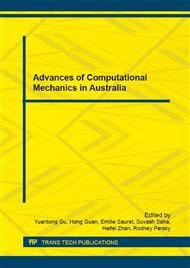[1]
D. Mitchell, Heavy vehicle productivity trends and road freight regulation in Australia, in Australasian Transport Research Forum 2010, Canberra, Australia, (2010).
Google Scholar
[2]
R. Karoumi, J. Wiberg, and A. Liljencrantz, Monitoring traffic loads and dynamic effects using an instrumented railway bridge, Engineering Structures. 27 (2005) 1813-1819.
DOI: 10.1016/j.engstruct.2005.04.022
Google Scholar
[3]
Australian Standard AS5100. 2, Bridge Design Part 2: Design loads, Standards Australia International Ltd, Sydney, (2004).
Google Scholar
[4]
L. Ding, H. Hao, and X. Zhu, Evaluation of dynamic vehicle axle loads on bridges with different surface conditions, Journal of Sound and Vibration. 323 (2009) 826-848.
DOI: 10.1016/j.jsv.2009.01.051
Google Scholar
[5]
C. G. Koh, K. K. Ang, and L. Zhang, Effects of repeated loading on creep deflection of reinforced concrete beams, Engineering Structures 19 (1997) 2-18.
DOI: 10.1016/s0141-0296(96)00028-4
Google Scholar
[6]
L. Zhang, et al., Effects of cyclic loading on the long-term deflection of prestressed concrete beams, Computers and Concrete. 12 (2013) 377-392.
DOI: 10.12989/cac.2013.12.6.739
Google Scholar
[7]
M. Pieraccini, et al., Interferometric radar vs. accelerometer for dynamic monitoring of large structures: An experimental comparison, NDT & E International. 41 (2008) 258–264.
DOI: 10.1016/j.ndteint.2007.11.002
Google Scholar
[8]
C. Gentile and G. Bernardini, Output-only modal identification of a reinforced concrete bridge from radar-based measurements, NDT & E International. 41 (2008) 544–553.
DOI: 10.1016/j.ndteint.2008.04.005
Google Scholar
[9]
C. Gentile and G. Bernardini, An interferometric radar for non-contact measurement of deflections on civil engineering structures: laboratory and full-scale tests, Structure and Infrastructure Engineering. 6 (2010) 521-534.
DOI: 10.1080/15732470903068557
Google Scholar
[10]
C. Gentile and G. Bernardini, Output-only modal identification of a reinforced concrete bridge from radar-based measurements, NDT & E International. 41 (2008) 544-553.
DOI: 10.1016/j.ndteint.2008.04.005
Google Scholar
[11]
C. Gentile, G. Bernardini, and P. Ricci, New interferometric radar for full-scale testing of bridges: 2. Ambient vibration tests & operational modal analysis, in 12th International Conference, Edinburgh, UK, Engineering Technics Press, (2008).
Google Scholar
[12]
G. D. P. Bernardini, G. Bicci, A. Marra, M. Coppi, F. Ricci, P., Microwave interferometer for ambient vibration measurement on civil engineering structures: principles of the radar technique and laboratory tests, in VACES'07 experimental vibration analysis for civil engineering structures. 2007: Porto, Portugal.
Google Scholar
[13]
M. Pieraccini, et al., Static and dynamic testing of bridges through microwave interferometry, NDT & E International. 40 (2007) 208–214.
DOI: 10.1016/j.ndteint.2006.10.007
Google Scholar
[14]
Australian Standard, AS 3600-2009: Concrete structures, Standard Australia, Sydney Australia, (2009).
Google Scholar
[15]
B. J. Lazan, Fatigue failure under resonant vibration conditions, University of Minnesota, USA, (1954).
DOI: 10.21236/ad0039439
Google Scholar
[16]
C. Menn, Prestressed concrete bridges, Birkhauser Verlag, Germany, (1990).
Google Scholar


